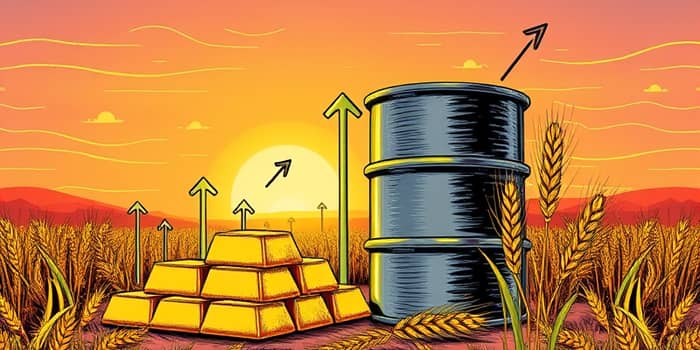
In an era of soaring prices and economic uncertainty, investors are seeking strategies to protect your hard-earned savings. As central banks across the globe grapple with rising inflation, traditional portfolios of stocks and bonds may struggle to maintain real value. Commodity ETFs offer a compelling alternative.
By offering liquid exposure to real-world commodities, these funds allow individuals to tap into the performance of energy, metals, and agricultural markets without handling physical assets or complex futures contracts.
Beyond numbers and charts, rising inflation affects everyday life—from higher grocery bills to steeper fuel costs. Seeing a cup of coffee cost 20% more within a year erodes confidence. By adding commodity ETFs, investors can find a practical tool for lasting financial security in uncertain times.
Inflation erodes purchasing power and can turn years of diligent saving into a diminished nest egg. Between 2021 and 2022, consumer prices in the US jumped sharply, while the S&P 500 fell by over 19% and bonds also suffered significant losses. During this same period, commodity indexes delivered robust gains, highlighting their ability to preserve purchasing power during inflation.
With central banks signaling higher interest rates and ongoing supply chain disruptions, adding an inflation hedge has never been more crucial. Investors must look beyond traditional assets to protect long-term wealth.
Consider a retiree living on a fixed income: as rent, utilities, and medication costs climb, their purchasing power diminishes rapidly. An allocation to commodities could soften these blows and maintain living standards. Protecting savings isn’t just about numbers—it's about safeguarding your family’s future against rising costs.
Commodity ETFs track the price movements of physical goods like oil, gold, copper, wheat, and more. Some are physically-backed funds holding actual commodities, while others invest in futures contracts to mirror market performance. Both structures aim to capture the upside when prices rise.
These ETFs trade on major exchanges just like stocks, offering daily liquidity and transparency. Investors can choose broad baskets that cover multiple commodities or narrow funds focusing on a single sector, such as precious metals or energy.
Some ETFs like physically-backed gold funds store actual bullion in vaults, offering direct link to tangible assets. Others track futures contracts across multiple delivery months. Futures-based ETFs can be affected by contango or backwardation, influencing returns. Understanding these nuances helps investors select funds that suit long-term investment goals and strategies.
Historical data underscores the inflation hedge qualities of commodities. According to a Vanguard report, a 1% increase in inflation has correlated with a 7–9% rise in commodity prices. From March 2021 to March 2022, a basket of 31 commodity ETFs returned an average of 45.2%.
During the most recent two-year inflationary cycle, broad commodity ETFs rose by over 60%, demonstrating their historical track record during inflationary spikes.
Compared with Treasury Inflation-Protected Securities (TIPS) and real estate, commodities boast the highest inflation beta, signifying the strongest historical response to rising prices. While TIPS shield against slower inflation scenarios and real estate can deliver rental income, only commodities have consistently matched or outpaced consumer price increases during sharp spikes.
When choosing a commodity ETF, consider key metrics such as the expense ratio relative to peers, average daily trading volume for liquidity, and the underlying index methodology. Funds with broad coverage and strong assets under management tend to exhibit tighter bid-ask spreads and more reliable performance.
While commodity ETFs shine during inflationary bursts, they exhibit low correlation with stocks and bonds, enhancing overall portfolio resilience. A typical allocation might reserve 5–15% of assets for commodity funds, adjusting based on risk tolerance and market outlook.
Investors should rebalance periodically and avoid overconcentration in any single resource. By combining broad and focused commodity ETFs, you can tailor exposure to your individual goals and economic forecasts.
For example, a hypothetical portfolio blending 60% equities, 30% bonds, and 10% commodity ETFs in 2021 would have seen smoother drawdowns and a faster recovery during market turbulence. Regular rebalancing—ideally on a quarterly basis—ensures that commodity exposure remains aligned with your risk profile.
Maintaining commodity exposure requires vigilance. Monitor seasonal trends, check futures curve shifts, and watch macroeconomic indicators like the US dollar index and supply chain reports. This active oversight enables investors to anticipate price swings and adjust allocations as needed.
In times of rising prices, commodity ETFs stand out as a robust tool to diversify away from stocks and bonds and retain purchasing power. Their proven performance in inflationary cycles, paired with easy access and daily liquidity, makes them a valuable addition to many portfolios.
Before investing, review your overall asset allocation and consider your investment horizon. By balancing potential rewards with the inherent risks, commodity ETFs can offer both protection and growth opportunities.
Ultimately, the goal is to build a resilient portfolio that weathers inflationary storms and helps meet life goals—whether saving for retirement, funding education, or passing wealth to future generations. By thoughtfully integrating commodity ETFs, investors gain a dynamic layer of defense against the erosion of purchasing power.
Take the first step today by researching top-rated commodity ETFs and envision how they can fortify your investment strategy against inflation. When inflation rises, let your portfolio stand strong—with a smart allocation to commodities guiding the way.
References













